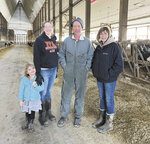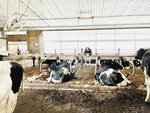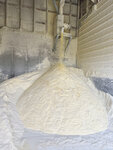


How many times a day do you milk, and what is your current herd average, butterfat, and protein? We milk the main herd twice a day, and we milk the fresh group four times a day. Our rolling herd average is 30,909 pounds of milk with 4.7% butterfat and 3.48% protein. Our herd is averaging 96 pounds of milk per head per day.
Describe your housing and milking facility. We have conventional freestall barns that have curtain sidewalls. One of our barns has free stalls that are equipped with waterbeds while the other has free stalls that are bedded with sand.
Who is part of your farm team, and what are their roles? Our team includes Cal and Char Lubben, their son, Chad, and his wife, Morgan. Cal is in charge of overall herd health, fresh cows, breeding and chopping silage. Char takes care of the calves and is the farm’s bookkeeper. Chad does the feeding, and Morgan is the herdswoman. Morgan also helps with the calves, breeding, herd records and fresh cows.
What is your herd health program? Our vet performs herd health checks every other week. We give the cows a J-5 vaccine at dry-off. They are vaccinated with SRP salmonella and ScourGuard two weeks later and are boosted throughout their dry period. Calves are given Nasalgen at birth. Close-up cows also receive a dose of Nasalgen.
What does your dry cow and transition program consist of? Our cows are given a dry period of 60 days. At dry off, we move them to free stalls that are bedded with sand. Three weeks prior to calving, they are moved into a pen that has a bedding pack. Our dry cow ration consists of straw, grass hay, rye silage, sorghum silage and corn silage. After calving, the animals are moved to our fresh cow pen where they remain for the next three weeks and get milked four times per day. They are then moved to either the heifer group or the mature cow group.
What is the composition of your ration, and how has that changed in recent years? Our total mixed ration contains haylage, cottonseed, liquid molasses, soybean meal, corn silage, finely ground corn and a protein/mineral mix. Adding finely ground corn and amino acid balancing has helped us achieve higher milk production and has increased milk components.
Tell us about the forages you plant and detail your harvest strategies. Our forage crops include winter rye, alfalfa, sorghum and corn silage. When we harvest our alfalfa, we cut it one day and chop it the next day. We pay very close attention to moisture levels. We have our own chopper, so we can stop and wait for the hay to dry before continuing to chop. Highly digestible forages are the foundation of high milk production.
What is your average somatic cell count, and how does that affect your production? Our current SCC is 118,000. Keeping our SCC low has helped us attain good milk production and components. We closely monitor our dairy facilities for stray voltage.
What change has created the biggest improvement in your herd average? The biggest improvement has been adding finely ground corn to the lactating ration. Doing this has increased our average daily milk production by 3-4 pounds. Grinding the corn down to 300 microns makes more of its starch available to the rumen yet doesn’t cause hemorrhagic bowel syndrome.
What technology do you use to monitor your herd? We monitor our herd with ID tags and track milk production with Dairy Herd Improvement Association and DairyComp.
What is your breeding program, and what role does genetics play in your production level? We use the double ovsynch protocol. We have been using A.I. for 40 years and do genomic testing on all of our calves. Our top cows and our heifers are bred to top bulls with sexed semen. The lower testing cows are bred to beef bulls.
List three management strategies that have helped you attain your production and component level. First was finely grinding our corn to 300 microns. Second was focusing more on our calves and making sure that they get the best possible start in life. We have also begun to pasteurize our colostrum and constantly monitor its quality, with the goal of it having a Brix score of 27-28. We make sure that all of our calves receive a gallon of high-quality colostrum within two hours of birth.
Tell us about your farm and your plans for the dairy in the next year. We are a multifamily, fourth-generation dairy farm. We have no big plans for the coming year. We just hope to keep getting better and, hopefully, be profitable and pay down debt. It’s possible that we will add tunnel ventilation to our freestall barns. There is no magic bullet to high production; it’s simply doing many little things right. High feed intakes means getting the cows to eat that extra mouthful of feed. We are averaging 58 pounds of dry matter intake per head per day. We have been with the same nutrition company for 40 years. I listen to podcasts and webinars and do a lot of reading, including the Dairy Star. Char and Morgan have implemented an excellent calf program with Purina and are getting 2 pounds of average daily gain in our calves. Because of that, we are beginning to see higher milk production from our first-calf heifers. Our goal is to get 8 pounds per head per day of combined fat and protein.
Comments
No comments on this item Please log in to comment by clicking here